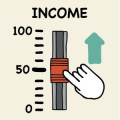 Educating freelance clients that they get what they pay for is an important part of the freelance marketing process. As a freelancer and a client, I strongly believe it is the freelancer’s job to sell themselves for the money he or she deems fair. Low-paid competition only makes it harder but nevertheless, it’s not the client’s fault there are people willing to work for pennies. The change lies within us, the freelancers.
Educating freelance clients that they get what they pay for is an important part of the freelance marketing process. As a freelancer and a client, I strongly believe it is the freelancer’s job to sell themselves for the money he or she deems fair. Low-paid competition only makes it harder but nevertheless, it’s not the client’s fault there are people willing to work for pennies. The change lies within us, the freelancers.
So let me tell you a story about educating clients about your prices and why you should stand up for yourself.
How it all began …
When I was releasing my first book on Amazon, I needed help with the book cover design. Provided the book was about oDesk (now Upwork), naturally I wanted to give back to the community and hire a designer through the platform.
A promising candidate disappointed me with unprofessional behavior and I described that incident in a post on this very blog (check out the first example in this post – it tells the whole story of the incident).
As a result of the post, I received some hate mail and comments in LinkedIn group discussions, saying that I am a hypocrite for encouraging people to charge top dollar for their skills and then, looking for a designer to create a book cover design for $75 (which apparently was very low budget).
It got me thinking – am I really a hypocrite? Am I preaching “only sell yourself for top dollar” to my fellow freelancers, and then I turn into one of those low paying clients with whom I absolutely refuse to work?
What really happened …
I am not a designer and I have no idea how much time the task requires, or how much it would cost to have a book cover designed for me. So I did my research on oDesk (now Upwork) since that was where I wanted to hire someone. I looked through the profiles and portfolios of many freelancers and one thing was clear – the going rates for good book cover design were between $50 and $100, depending on what exactly I wanted. When publishing my job post, I aimed at the middle – $75.
I would have happily paid more – it’s just that nobody ever asked for more. Not one person told me this is too low budget for cover design. Nobody refused the contract for the reason of the budget being too low. Furthermore, I received many proposals way below the budget. Not to mention that in the end I did get a great cover within the budget.
In hindsight, I probably missed a lot of good designers because I set the budget too low, but I couldn’t have known that, unless someone educated me as a client about it. Not being a designer myself, I asked for what the market offered without a reference point from experience.
What should happen in such cases, ideally …
It would be much more useful for everyone if freelancers don’t get offended by low prices but push market rates upward by simply educating clients.
As a freelancer, I always try to help clients understand the budgeting process. I have had several clients who were awesome to work with but initially, they set unrealistic budgets because they had no idea about the work involved, the time needed for implementation, or any other factor they couldn’t take into account due to lack of marketing background and experience.
If you find yourself in such a situation, you have a couple of options – move on (maybe even make a sarcastic remark and have condescending attitude), or try and help out a client and land a gig in the process.
Most of the times, I choose option 2. It has paid out very well and more importantly, it has been an awesome way to start a relationship.
Do you educate clients about your work process and pricing strategies?
I would love to hear if this approach has helped you, or why not.
P.S. Another time I’ll talk about when enough is enough and it’s not a good idea to educate a client. 😉





Hi Diana
It just so happens I’m moving away from giving prospects an itemised quote, with a single price, to one with 3 prices based on different service levels.
The main reason is that many prospects simply don’t know what’s involved in my work. And, because of that, they often just base their hiring decision on price.
But, by splitting out my price into 3 packages, I’m educating the prospect by telling them what they get for their money at each service level.
If some just want the basics then they can get them for a lower price – and I might not lose business to someone charging a lower rate.
But when the client sees what’s on offer for each package level they should at least have a better understanding of why they may actually need to pay more.
This sounds like a sound approach, Kevin – I believe it will bring more value to your clients and more appreciation (and money, end of he day) for your practice. Thanks for sharing your pricing strategy and more power to you 😀
~Diana
Great post, Diana! I’m also a freelancer on Upwork, and, admittedly, I sometimes get frustrated by the low-budget job posts or invitations that I receive – so much so that I haven’t submitted a proposal in at least two months.During that time I’ve only worked with private clients along with accepting invitations from clients who post jobs within my normal rate range. Generally, I do tend to decline or pass over job posts that are well below what I would consider average rates.
I’ve often thought, though, that maybe some of the clients that post jobs on the platform simply do not know what budget to set for their projects. On the flip-side, I’ve also often thought that clients don’t take into consideration the time investment and overhead costs that a freelance writer endures in order to stay in business; that they only see writing as an “easy gig” and are only willing to pay based on the number of words produced. Some clients I honestly don’t think they take into consideration the research time involved in creating a quality article for them. However, on rare occasions, and because I realize that some clients may legitimately be unaware of what standard rates are for writing projects, I will tell the low-budget clients that their budget is too low, explain what my average rate for similar work is, and mention that if their budget can meet my standard rates, then I’ll be more than happy to help them with their project.
I also believe that part of the problem is on the freelancer’s side. Many writers begin their career with little to no previous professional writing experience, therefore are not sure of what the “standard” rates are for various writing tasks. I can honestly say that for some projects that I’ve been offered that have helped me to expand my skills and experience, I have more than likely quoted low. Three years into freelancing, and my husband still tells me that he believes my rates are too low. Judging by rate suggestions on sites like the EFA and the Writers Market, he could be quite right!
I’m in the process of re-planning my business for 2016, though, which includes restructuring my pricing schedule among other things.
Awesome comment, Dawn – thanks for taking the time to share your thoughts here 😀 To your last note – I don’t know what type of writer you are or how much you charge, but I think your husband might be right. I read somewhere once (and since then, it’s kind of a motto of mine) – if you don’t feel uncomfortable when giving your rate to a client, you are not quoting enough. 😉
~Diana
There’s a great lesson here. I do believe that educating the customer has enormous value. I like the idea of offering packages with different level of services so that clients can see where their dollars are going and for what.
Agreed – as always 😉 Glad to see you around and about, Jacquie!
~Diana
Hi,
Well I’m also a freelancer but I rarely use Upwork, I work only for private clients since the budget is fixed and I know what they really want.
Its really great to learn lot of things from this post.
Thanks
Hi, Barry – it doesn’t really matter if you use Upwork or not, as long as you are happy with the work you do and the clients you work with. Often, lessons from or about Upwork are pretty much applicable for any other channel to attract clients. I’m glad you found the post helpful . See you around more, then? 😀
~Diana
Offering different level pricing — with different levels of service — is something I’ve often done. What shouldn’t be done is to lower your price and then perform the same service you would for the higher price. If a client wants to pay less then cut back on what you’re offering, or decline the assignment.
Amen to that, Jeannette – sometimes it is hard to explain this concept to starting freelancers… or to clients, for that matter 😀
~Diana
Hey Diana,
Good to be on your blog today; I came in through a comment you dropped on Brent’s guest article on Ash’s blog. Your blog here is clean and welcoming 😉
Now, about the topic, we have the responsibility to educate our clients. The truth is that many of them don’t even know what it takes to get the final product delivered. They take us for our words.
If you sell out too cheap like most of them do on fiverr, you end up getting less value for your time. The end result is poor quality
I think if clients need a good job, they should pay the worth and the freelancer’s duty is to let the client know what the worth is.
I’m happy I was here. Hope to be around again
Hi Diana,
Wonderful post I guess, every time I visit here I can see a great post has been published. Well I’m a freelance designer and I guess your tips are really helpful.
Thanks for share.
Absolutely right. One very simple way to educate is a pricing page on your website. Not only ca you show a range of prices for the job(s) you do, but it also allows you to highlight what makes you different from your competitors, what your client gets for the money you charge them.
Also: good service these days is a great differentiator, and the good thing is your clients get a “free preview” during these first interactions, up to and including the actual quote. I think pat of the education, then, is done quite simply by being your best self from the start. I know by comparison alone, you will stand out from the crowd. And to clients for whom this matters, they will definitely notice.
But above all, there’s no better learning experience than becoming a client, and going through the process ourselves. Kudos for being so transparent about it!
Thanks for joining the conversation Jean, adding great value to it, too!
More power to you 🙂
~Diana